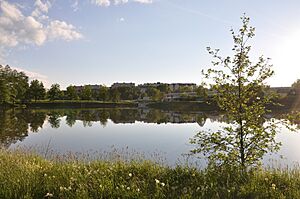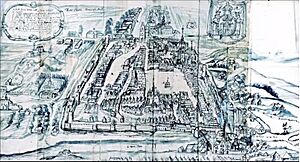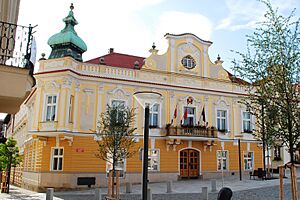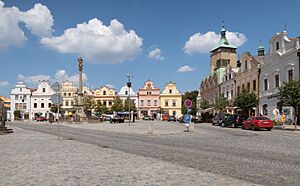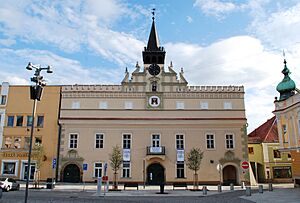Havlíčkův Brod facts for kids
Quick facts for kids
Havlíčkův Brod
|
|||
|---|---|---|---|
|
Town
|
|||
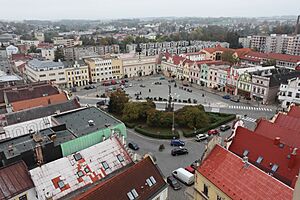
Havlíčkovo Square seen from the church tower
|
|||
|
|||
| Country | |||
| Region | Vysočina | ||
| District | Havlíčkův Brod | ||
| First mentioned | 1256 | ||
| Area | |||
| • Total | 64.93 km2 (25.07 sq mi) | ||
| Elevation | 422 m (1,385 ft) | ||
| Population
(2024-01-01)
|
|||
| • Total | 23,746 | ||
| • Density | 365.72/km2 (947.20/sq mi) | ||
| Time zone | UTC+1 (CET) | ||
| • Summer (DST) | UTC+2 (CEST) | ||
| Postal code |
580 01
|
||
Havlíčkův Brod is a town in the Vysočina Region of the Czech Republic. It is home to about 24,000 people. The town's old centre is very well kept. It is even protected by law as a special historic area.
Contents
Understanding the Name
The word brod in Czech means 'ford'. A ford is a shallow place in a river where you can cross. The town was first called Brod. Then it became Smilův Brod, named after its founder, Smil of Lichtenburk.
In the 1300s, the town's name changed to Německý Brod. This meant "German Ford" because many German people lived there. After World War II, people wanted to remove German names. So, in 1945, the town was renamed Havlíčkův Brod. This means "Havlíček's Ford." It honors Karel Havlíček Borovský, a famous writer who grew up and studied in the town. This was the first town to be renamed in 1945.
Where is Havlíčkův Brod?
Havlíčkův Brod is located right in the middle of the Czech Republic. It is about 21 kilometers (13 miles) north of Jihlava. The town sits in the Upper Sázava Hills.
The Sázava River flows through the town. Many smaller streams also run through the area. These include Cihlářský potok, Žabinec, and Šlapanka. There are also many fishponds. Some of these ponds are in the town itself. Cihlář Pond is the largest and is used for fun activities like water sports. The biggest body of water in the area is the Žabinec water reservoir.
A Look at History
Some old stories say Brod was founded in 793, but this is probably not true. The first real mention of the town is from 1265. Smil of Lichtenburk likely founded the town in 1251. It was built on an important trade route. In 1308, it was first called Německý Brod.
Brod was first known for silver mining. Later, it became a centre for crafts and farming. During the Hussite Wars in 1422, the town was attacked by Jan Žižka and completely destroyed. After this, mostly Czech-speaking people moved back to the town. In 1436, the Trčka of Lípa family bought Brod. The town was rebuilt and became very successful in the 1500s and 1600s. In 1637, it became a royal town.
However, the good times ended with the Thirty Years' War. Brod was attacked and robbed twice. In 1646, 1664, and 1680, the town suffered from serious sicknesses. Big fires also damaged the town in 1662 and 1676. The worst flood happened in 1714.
In the 1800s, the town started to grow again. In 1850, Brod became a district town. Factories were built in the late 1800s, focusing on clothes and food. A railway was built in 1870. The train station later became a very important travel hub. Until 1918, the town was part of Austria-Hungary.
Population Changes
| Historical population | ||||||||||||||||||||||||||||||||||||||||||||||||||||||||
|---|---|---|---|---|---|---|---|---|---|---|---|---|---|---|---|---|---|---|---|---|---|---|---|---|---|---|---|---|---|---|---|---|---|---|---|---|---|---|---|---|---|---|---|---|---|---|---|---|---|---|---|---|---|---|---|---|
|
|
|
||||||||||||||||||||||||||||||||||||||||||||||||||||||
| Source: Censuses | ||||||||||||||||||||||||||||||||||||||||||||||||||||||||
What Havlíčkův Brod Makes and Does
Havlíčkův Brod has a medical hospital and a mental hospital. These are two of the biggest employers in the town.
Some main factories in the town include Futaba Czech s.r.o. They make parts for cars. Pleas a.s. makes underwear. This company started in 1939 and continues the town's long history of making textiles (cloth).
The Havlíčkův Brod Brewery is also in the town. It has been making beer since 1834.
Getting Around
Havlíčkův Brod is a major hub for both roads and railways. Five train lines leave from the main station. They go to cities like Kolín, Prague, Pardubice, and Brno. There are also smaller local lines. Besides the main station, there are four other train stops in the town's area.
Two main roads cross in the town. Road I/34 goes from České Budějovice to Svitavy. Road I/38 goes from Mladá Boleslav to Jihlava and the border with Austria.
There is also a small airport near the town. It is mostly used for sports and sightseeing flights.
Sports in Town
The town has an ice hockey team called BK Havlíčkův Brod. They used to play in a top Czech league until 2015.
FC Slovan Havlíčkův Brod is the town's football (soccer) club. They play in lower amateur leagues.
Places to See
The old town centre was once surrounded by walls. You can still see parts of these walls today. In the middle of the centre is Havlíčkovo Square. This square has beautiful old houses. They are built in Renaissance and Baroque styles. Some even have parts from the Gothic period.
The most important building on the square is the Old Town Hall. This building was first built in the late 1400s. It was rebuilt after a big fire in 1662. Inside, there is a skeleton. It is a symbol of the town. The story says it belonged to someone who betrayed the town in 1472. Today, the building is a library. It is so important that it became a national cultural monument in 2024.
Across from the Old Town Hall is the New Town Hall. This building was first built in the 1200s. It was once a brewery and army barracks. It was last rebuilt in 1884. Now, it holds the town's main offices. On the north side of the square is Havlíčkův House. This building is owned by the town. It houses the Vysočina Museum.
The Church of the Assumption of the Virgin Mary is the oldest church in Havlíčkův Brod. It was first built in the late 1200s by the Teutonic Order. It was rebuilt several times. The church's tower is 51 meters (167 feet) tall. It is the main landmark of the town. The tower has one of the oldest bells in the country, made in the 1330s. You can visit the tower.
Štáfl Cottage is a special old house. It shows unique folk architecture. The oldest parts of the house are from the 1500s. It is also a national cultural monument.
Famous People from Havlíčkův Brod
- Jan František Beckovský (1658–1725), historian and writer
- Johann Stamitz (1717–1757), composer and violinist
- Josef Dobrovský (1753–1829), language expert and historian; studied here
- Karel Havlíček Borovský (1821–1856), writer and poet; lived here
- Bedřich Smetana (1824–1884), famous composer; studied here
- Jan Zrzavý (1890–1977), painter; studied here
- Karel Kuttelwascher (1916–1959), fighter pilot
- Pavel Landovský (1936–2014), actor
- Jaroslav Holík (1942–2015), ice hockey player and coach
- Jiří Holík (born 1944), ice hockey player and coach
- Jan Suchý (1944–2021), ice hockey player
- Josef Augusta (1946–2017), ice hockey player and coach
- Tomáš Souček (born 1995), footballer
- Vítek Vaněček (born 1996), ice hockey player
Town Partnerships
Havlíčkův Brod has special partnerships with other towns. These are called "twin towns" or "sister cities."
 Brielle, Netherlands
Brielle, Netherlands Brixen, Italy
Brixen, Italy Spišská Nová Ves, Slovakia
Spišská Nová Ves, Slovakia
Havlíčkův Brod also works with other towns in the Czech Republic that have "Brod" in their name. These include Český Brod, Uherský Brod, and Železný Brod.
Images for kids
See also
 In Spanish: Havlíčkův Brod para niños
In Spanish: Havlíčkův Brod para niños





